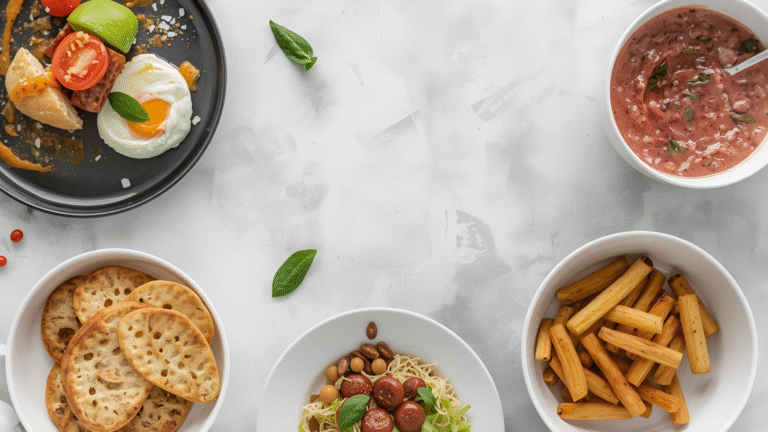Food Content Trends in March
Explore March food trends: plant-based proteins, bold flavors, Easter treats, and sustainable dining. Discover innovative recipes and products.
March marks a vibrant shift in the culinary world, driven by seasonal transitions, cultural celebrations, and evolving consumer preferences. As spring begins in the Northern Hemisphere and fall arrives in the Southern Hemisphere, food trends reflect a dynamic blend of health-conscious choices, indulgent treats, and bold global flavors. From plant-based innovations to holiday-inspired creations, this month’s food scene is all about creativity, authenticity, and sustainability. This article dives into the key trends shaping March, offering insights for food enthusiasts, bloggers, and brands looking to stay ahead of the curve.
1. Health and Wellness: A Functional and Clean Approach
Health-conscious eating continues to dominate consumer preferences, with a focus on functional foods, clean ingredients, and plant-based alternatives. March, coinciding with National Nutrition Month, sees brands and consumers prioritizing nutrition over calorie counting, emphasizing high-fiber, protein-rich, and gut-friendly options.
Plant-Based Proteins Take Center Stage
The demand for plant-based proteins has surged, with innovations in pea protein, mushroom-based products, and plant-based butcheries gaining traction. Consumers are seeking sustainable, meat-free alternatives that don’t compromise on taste or texture. For example, brands like Beyond Meat and Impossible Foods continue to expand their portfolios with products like plant-based sausages and burgers, while smaller innovators introduce mushroom-based jerky and pea protein nuggets.
Clean Ingredients and Transparent Labeling
The clean-label movement is reshaping the food industry, driven by consumer concerns about ultra-processed foods. Brands are responding with products featuring short, recognizable ingredient lists. UK retailer Marks & Spencer (M&S) leads this trend with its “Only…Ingredients” portfolio, including viral single-ingredient cornflakes made solely from corn. This transparency builds trust, allowing consumers to make informed choices without deciphering complex labels.
Functional Foods with Adaptogens
Functional foods are moving beyond basic nutrition to include ingredients like adaptogens, which are believed to support stress relief and overall balance. M&S’s YAY! Mushrooms range, featuring lion’s mane and reishi mushrooms, exemplifies this trend. These drinks, verified by experts at the Royal Botanic Gardens, Kew, cater to consumers seeking mental clarity and energy boosts. Similarly, CLIF BAR’s Caffeinated Collection, launched in collaboration with athletes Breanna Stewart and Frances Tiafoe, offers energy bars with caffeine and B12 to enhance performance.
Low-Sugar and High-Fiber Options
With growing awareness of sugar’s impact on health, low-sugar and high-fiber products are in high demand. San Pellegrino’s Zero Added Sugar range, with 0g added sugar and 22 calories per 330ml, caters to this trend. Breakfast bars, cereals, and snacks are also reformulated to emphasize fiber, supporting digestive health and sustained energy.
| Health-Focused Product Examples | Key Features | Brand |
|---|---|---|
| YAY! Mushrooms Drinks | Lion’s mane, reishi, adaptogens | M&S |
| Caffeinated Collection Energy Bars | Caffeine, B12, performance-focused | CLIF BAR |
| Zero Added Sugar Beverages | 0g added sugar, 22 calories/330ml | San Pellegrino |
| Single-Ingredient Cornflakes | 100% corn, no additives | M&S |
2. Indulgent Treats with a Twist
While health trends dominate, indulgence remains a key driver, especially with holidays like Easter and St. Patrick’s Day. March sees brands reimagining classic treats with creative twists, bold flavor fusions, and visually appealing presentations.
Dubai Chocolate: A Viral Sensation
The Dubai chocolate trend, characterized by pistachio-knafeh fillings and striking aesthetics, continues to captivate consumers globally. Its popularity, fueled by TikTok’s viral videos, highlights the power of social media in driving food trends. Brands like Lindt have tapped into this craze with pistachio bars, while Morrisons introduced a Dubai-inspired chocolate Easter egg, blending creamy pistachio with crunchy knafeh for a shareable, indulgent treat.
Nostalgia Reimagined
Nostalgic flavors are being reinvented with modern twists. M&S’s “dippy egg” hot cross buns combine the familiar taste of hot cross buns with a playful nod to childhood breakfasts, tapping into both nostalgia and shareability. Similarly, Honey Bunches of Oats collaborated with pastry innovator Dominique Ansel to launch a chocolatey cereal that elevates the classic breakfast experience.
Playful and Interactive Treats
Interactive elements are transforming indulgent products. Sour Patch Kids Glow Ups, the first gummy candy to glow under blacklight, use turmeric extract to create a fluorescent effect, appealing to younger consumers seeking fun, Instagrammable experiences. Likewise, Eggo Ice Cream, in collaboration with Kellanova and Golden West Food Group, introduces flavors like Buttery Maple and Chocolately Chip, merging breakfast and dessert for a whimsical treat.
| Indulgent Product Examples | Unique Feature | Brand |
|---|---|---|
| Dubai-Inspired Easter Egg | Pistachio-knafeh filling | Morrisons |
| Dippy Egg Hot Cross Buns | Nostalgic breakfast twist | M&S |
| Glow Ups Gummies | Glows under blacklight | Sour Patch Kids |
| Eggo Ice Cream | Breakfast-dessert fusion | Kellanova |
3. Holiday-Inspired Culinary Creations
March is packed with holidays that shape food content, from St. Patrick’s Day to Easter, Ramadan, Holi, and Purim. Each celebration inspires unique recipes, products, and dining experiences that resonate with cultural traditions and modern tastes.
St. Patrick’s Day: Green and Festive
St. Patrick’s Day on March 17 inspires a wave of green-themed foods and drinks. Traditional Irish recipes like soda bread, roasted potatoes, and whiskey cocktails remain popular, but bloggers and brands are also experimenting with naturally green dishes. For example, the 5 Minute Magic Green Sauce, a vibrant blend of herbs and avocado, is a versatile recipe for dips, dressings, or marinades, perfect for festive gatherings.
Easter: Beyond Chocolate Eggs
Easter sees a shift away from traditional chocolate eggs as consumers prioritize health and variety. Nestlé Confectionery’s Easter collection includes innovative treats like M&M’s Crispy Bunny and Maltesers Popcorn Bunny, while NOMO offers plant-based, allergen-free eggs to cater to diverse dietary needs. Sustainability is also key, with brands using eco-friendly packaging to align with consumer values, especially as cocoa prices rise by up to 50%.
Holi and Global Celebrations
Holi, the Hindu Festival of Color, inspires vibrant dishes like Gujiya (sweet dumplings), lassi (yogurt-based drinks), and pakore (fritters). Food bloggers can put their spin on these recipes, incorporating bold colors and flavors to reflect the festival’s spirit. Similarly, Lunar New Year menus feature dumplings and rice cakes, while Ramadan brings date-based desserts and savory iftar dishes.
March Madness: Game-Day Snacks
March Madness, running from March 18 to April 7, inspires basketball-themed finger foods and dips. Bloggers can engage audiences with recipes like spicy buffalo wings, cheesy nachos, or a March Madness recipe bracket to crown the ultimate fan-favorite dish.
4. Bold Global Flavors and Cultural Fusion
Consumers are embracing adventurous, globally inspired flavors, with brands blending cultural elements to create unique culinary experiences. Spicy, smoky, and tangy profiles are particularly popular, alongside authentic regional ingredients.
Hot and Spicy Dominance
The “swicy” (sweet and spicy) trend continues to thrive, with products like KFC’s Hot Honey menu, featuring drizzled tenders and Secret Recipe fries, capturing consumer attention. McCoy’s Hot ‘N’ Spicy Crisps and Heinz’s Flavor Tour condiments, including Thai Sweet Chilli and Mexican Street Corn, further showcase this trend’s global appeal.
Emerging Flavors
While hot and spicy flavors dominate, emerging profiles like yuzu, harissa, and za’atar are gaining traction. These ingredients add complexity to snacks, sauces, and marinades, appealing to foodies seeking novel taste experiences. AI-driven flavor prediction is also helping brands identify the next big global flavor.

5. Social Media and Digital Influence
Social media platforms like TikTok and Instagram continue to shape food trends, with visually appealing products and influencer collaborations driving rapid adoption. The Dubai chocolate trend’s viral success is a prime example, with its photogenic presentation fueling consumer demand. Brands are also partnering with influencers and artists to create buzz-worthy products, such as Honey Bunches of Oats’ collaboration with Dominique Ansel.
Influencer-Driven Collaborations
Collaborations are key to staying relevant. The House of Creed’s partnership with The St. Regis Hotel in Toronto for an exclusive Afternoon Tea experience merges luxury fragrance with fine dining, creating a multisensory event that resonates with affluent consumers. Similarly, Mr. Charlie’s plant-based “Mr. Fluff-Head” ice cream, made from potatoes, leverages its third-anniversary milestone to generate social media buzz.
6. Sustainability and Regional Authenticity
Sustainability remains a priority, with consumers favoring brands that reduce packaging and prioritize eco-friendly practices. Easter products, for instance, increasingly feature recyclable materials. Regional authenticity also resonates, as seen in Walkers’ Worcester sauce comeback, tied to a River Severn activation that celebrates its geographical roots.
Non-Alcoholic Beverage Surge
Sainsbury’s inclusion of alcohol-free beers like Lucky Saint and Corona Cero in its £5 meal deals reflects the growing demand for non-alcoholic options, particularly among Gen Z. This move, while controversial for lunchtime consumption, underscores the importance of diverse beverage choices.
| Non-Alcoholic Beverage | Price | Key Feature | Brand |
|---|---|---|---|
| Lucky Saint | £5 (meal deal) | Alcohol-free lager | Sainsbury’s |
| Corona Cero | £5 (meal deal) | Zero-alcohol beer | Sainsbury’s |
| Kombucha (Strawberry Mint) | £2.50/330ml | Low-sugar, fermented tea | Lipton |
7. Gardening and Seasonal Ingredients
As spring begins, gardening content gains traction, with food bloggers sharing tips for growing edible gardens. Recipes featuring fresh vegetables like asparagus, peas, and radishes align with this trend. In the Southern Hemisphere, fall ingredients like pumpkins, pears, and Brussels sprouts inspire hearty dishes.
Recipe Idea: Spring Garden Salad
A vibrant salad featuring homegrown greens, radishes, and a lemony vinaigrette is perfect for March. Pair it with a plant-based protein like grilled tofu for a complete meal.
Conclusion
March is a melting pot of culinary innovation, blending health-conscious choices, indulgent treats, and bold global flavors. From plant-based proteins and clean-label products to viral Dubai chocolate and sustainable Easter treats, the food industry is responding to consumer demands for authenticity, creativity, and sustainability. Holidays like St. Patrick’s Day, Easter, and Holi provide opportunities for brands and bloggers to connect with audiences through festive recipes and products. By leveraging social media and embracing emerging trends like “swicy” flavors and non-alcoholic beverages, the culinary world is poised for a dynamic spring season.
For brands looking to capitalize on these trends, tools like Foods Connected’s Product Lifecycle Management solution can streamline development and ensure alignment with consumer preferences. Whether you’re a foodie, blogger, or brand, March offers endless inspiration to create, innovate, and indulge.
Please share these Food Content Trends in March with your friends and do a comment below about your feedback.
We will meet you on next article.
Until you can read, Food Content Trends in January






